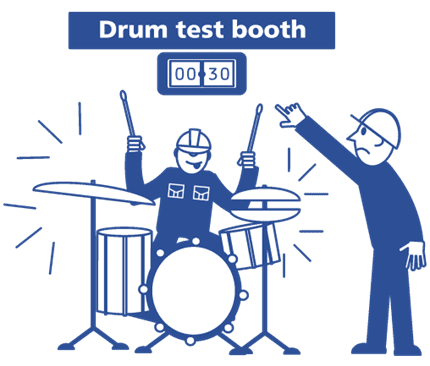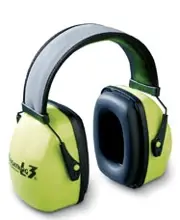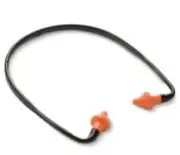Before looking at how to measure and control hazardous noise exposure, it is important to understand how noise is measured, including the length of time of exposure.
Noise intensity is measured in decibels (dB). The decibel scale is a little unusual because the sensitivity of the ear allows us to hear an extremely large range of sounds, so an increase of 10dB is a 10x increase in intensity.
For example, general city traffic is around 70dB, which is 10x louder than the noise of a normal conversation, which is around 60 dB.
For more information on decibels and how loud certain common sounds are, click here to view our Knowledge Bank article on measuring noise levels.
How is noise exposure measured?
An employee’s occupational noise exposure is usually measured in LEP,d, which represents the daily ‘dose’ of noise they are exposed to (normalised to an 8-hour day). It is calculated by combining information on how loud the various noises that a person is exposed to in a working day are, and how long they are exposed to each of them.
For example, all three of the following levels of exposure have an LEP,d of 80 dB:
80 dB for 8 hours.
89 dB for 1 hour.
92 dB for 30 minutes.
How do you assess noise exposure?
Employers must measure the noise level employees are exposed to for compliance with the Control of Noise Regulations 2005. This includes carrying out an occupational noise assessment.
There are several ways to obtain a worker's LEP,d (daily noise exposure level), including:
Using a sound level meter to measure the LAeq (average sound level measurement) at each working location, and then finding out how long the worker spends at each location.
Mounting a noise dosimeter to the worker's shoulder, which will measure their noise exposure for a full shift.
Using data provided by a tool’s manufacturer to determine how much noise it produces, and determine how long the worker spends using the tool.
The likely peak sound pressure levels, (LCPEAK), to which workers are exposed should also be measured.
For those employees whose daily exposure to loud noise varies significantly, their weekly noise exposure (LEP,w) should be calculated instead.
Once the relevant information has been gathered, an employee’s LEP,d or LEP,w can be calculated using the exposure calculators and ready reckoners provided on the Health and Safety Executive (HSE) website.
What are the UK's noise action levels?
The Control of Noise at Work Regulations outlines several exposure action values and an exposure limit value.
An exposure action value is a level of noise at which specific action must be taken.
The exposure limit value is the level of noise at the ear above which an employee must not be exposed.
These values are as follows:
Value | Daily/weekly exposure | Peak exposure |
Lower exposure action value | 80 dB(A) | 135 dB(A) |
Upper exposure action value | 85 dB(A) | 137 dB(A) |
Exposure limit value | 87 dB(A) | 140 dB(A) |
An employer may need to take several steps depending on the level of noise that an employee is exposed to.
Above the lower exposure action value
Perform a risk assessment that identifies those risks associated with noise in the workplace.
Provide suitable hearing protection to employees, but they are not required to enforce its use.
Provide employees with suitable information, instruction and training on the current noise levels and their risks in the workplace.
Above the upper exposure action value
Reduce noise exposure levels as far as is reasonably practicable (without using hearing protection).
Provide employees with suitable hearing protection where noise levels cannot be sufficiently controlled in any other way.
Measure the noise levels throughout the workplace and mark those areas with high levels of noise as hearing protection zones, in which the use of hearing protection is required and enforced.
Provide those employees who work in hearing protection zones with regular hearing/audiometric tests.
Above the exposure limit value
It is illegal for employees to be exposed to noise levels that exceed the exposure limit value. However, they can work in areas that are louder than, as long as an employer can prove they have provided suitable hearing protection that reduces the risk of hearing loss and an employee’s exposure to a level below the exposure limit value.
How can you manage noise exposure?
When considering ways to reduce noise and noise exposure, a hierarchy of control methods should be followed:
Think about how to remove the source of noise altogether. For example, a noisy machine could be moved so it cannot be heard by workers.
If not possible, consider using quieter equipment or quieter processes.
Next, ensure equipment is well maintained so it continues to be effective and as quiet as possible.
If noise elimination is impossible, consider designing the workplace to create quiet workstations.
Use absorbent screens, barriers and enclosures to surround noisy equipment.
Limit the time people spend in noisy areas.
Provide employees with personal hearing protection.
Managing noise exposure with personal hearing protection
Hearing protectors, such as ear defenders and earplugs, should be considered a last resort. This is because it relies on an employee remembering to use it and using it correctly.
We will look at three of the most common forms of hearing protection below. You should seek specialist help when choosing ear protection.






